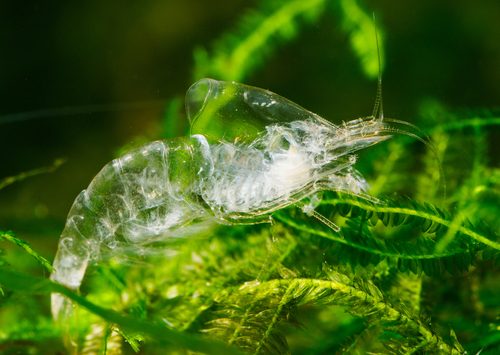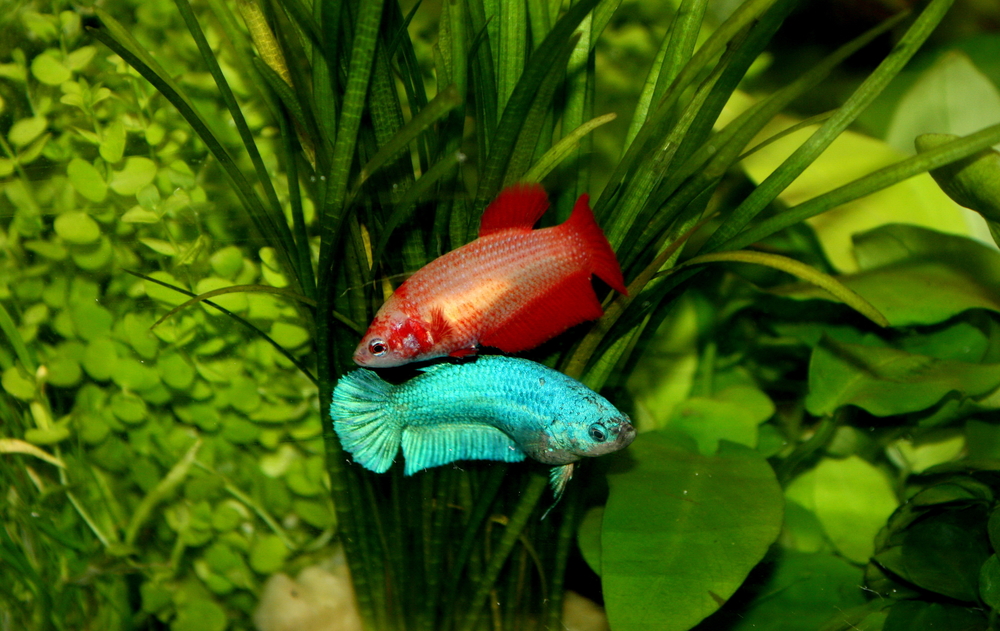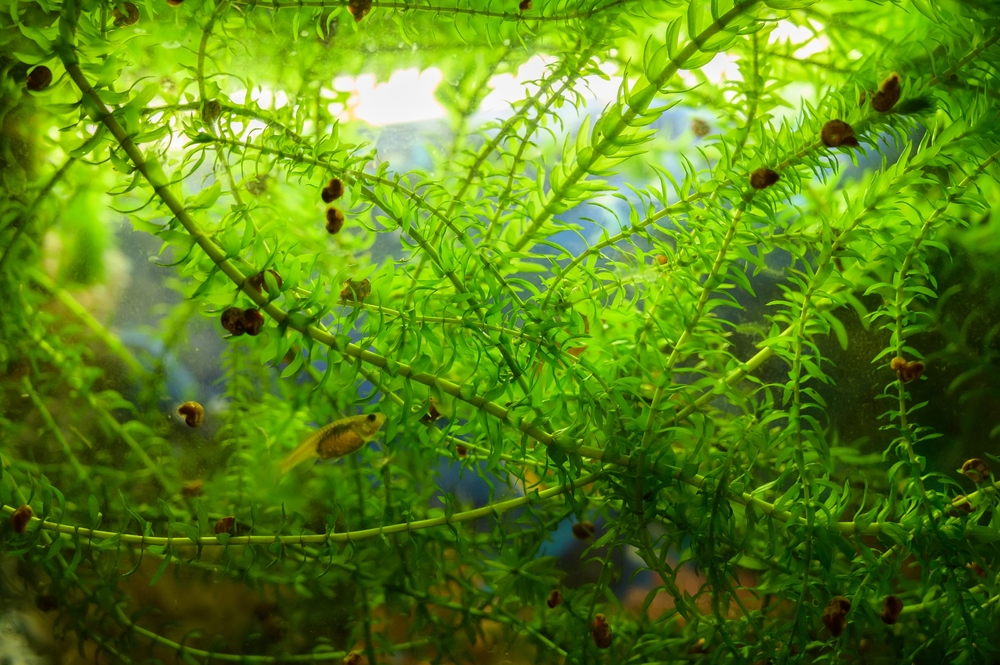Aquarium enthusiasts often explore the dynamic between different species to create a vibrant, diverse ecosystem within their tanks. The combination of shrimp and betta fish is particularly intriguing due to the known predatory nature of bettas and the peaceful demeanor of shrimp.
While it is possible for bettas to cohabit with shrimp, a successful companionship heavily relies on the individual personality of the betta and the environmental conditions within the aquarium.

It is crucial to consider the temperament of the betta fish alongside creating a structured habitat that caters to the needs of both species. Ideally, the tank should provide ample hiding spots for shrimp to escape to if they feel threatened.
At the same time, maintaining pristine water conditions and implementing a feeding regimen that satisfies both the betta’s carnivorous appetite and the shrimp’s dietary requirements are necessary to minimize potential conflicts.
Contents
Key Takeaways on Can Shrimp Live with Betta Fish?
-
- Bettas and shrimp can cohabit, but success depends on the betta’s temperament.
-
- A well-structured tank with hiding places is essential for shrimp safety.
-
- Proper water conditions and tailored feeding practices are key to cohabitation success.
Don’t miss out on these other popular picks:
Can Betta Fish Eat Tropical Flakes?
Why Is My Betta Fish Not Eating?
Neon Tetras with Betta: Can They Coexist Peacefully in Your Aquarium?
Understanding Betta Fish Behavior
In my years of aquaristics, I’ve learned that understanding the behavior of betta fish is crucial when considering tank companions like shrimp. Their temperament, space requirements, and gender-specific traits are key factors to their well-being.
Temperament and Aggression
Betta fish, also known as Siamese fighting fish, are known for their aggressive behavior, especially among males. They can show aggression by flaring their gills to intimidate rivals. This behavior is often exacerbated by stress, which can be caused by various factors including inadequate space or inappropriate tank mates.
A common misconception is that all betta fish are overtly aggressive; while it is true for many, each fish has its own personality, some being relatively peaceful.
Gender-Specific Behavior

Male betta fish are typically more territorial than females, often leading to a distinct pecking order within the tank. In comparison, females can coexist more peacefully and are less likely to display aggressive behavior when housed with other females in what’s known as a betta sorority.
However, even females will show aggression if the balance in their environment is not suitable.
Space and Territory
One of the most critical aspects I focus on is providing adequate space to mitigate territorial disputes. Betta fish, both male, and female, are territorial by nature and require sufficient space to establish their own domains.
A cramped environment can lead to increased stress and conflicts, negatively impacting their health and the harmony within the tank.
Shrimp as Tank Mates for Bettas
Choosing the right tank mates for bettas can enhance your aquarium’s community dynamics. In my experience, introducing shrimp to a betta tank requires consideration of compatibility, risks, and benefits, ensuring a harmonious environment for all inhabitants.
Suitable Shrimp Species
In my aquariums, I have found several shrimp species well-suited as tank mates for bettas. These include:
-
- Amano Shrimp: Renowned for their algae-eating abilities, Amano shrimp are larger, making them less likely to be seen as prey by bettas.
-
- Cherry Shrimp: Vibrant and active, Cherry shrimp add color to a tank and are generally peaceful, coexisting well in a betta fish community.
-
- Ghost Shrimp: Almost transparent, Ghost shrimp are skilled at blending in, which can help them evade bettas’ attention.
It’s important to note that while Bamboo shrimp and Bee shrimp are fascinating, their delicate nature often makes them less suitable for living with bettas due to potentially aggressive interactions.
Risks and Benefits

When adding shrimp to a community tank with bettas, it’s essential to weigh the potential risks and benefits.
Benefits:
-
- Shrimp, especially species like Amano shrimp, are beneficial for their algae-eating habits, helping to keep the tank clean.
-
- Shrimp can coexist peacefully with bettas, adding to the tank community diversity and aesthetic.
Risks:
-
- There is a risk of bettas viewing shrimp as food, particularly smaller or more vibrantly colored species.
-
- Shrimp may become stressed and vulnerable if a betta exhibits aggressive behavior, leading to an unhealthy tank environment.
To minimize risks, I recommend a spacious tank with plenty of hiding spots and live plants to provide shelter for shrimp. Compatibility can often hinge on the temperament of the individual betta, so monitoring their interaction is crucial.
Creating a Safe Aquarium Environment
When setting up an aquarium for both betta fish and shrimp, pay close attention to the tank size and the interior design, including adequate hiding spaces. This balance can make cohabitation peaceful and safe for both species.
Tank Setup and Size
For a thriving shared environment, I recommend a minimum of a 10-gallon tank to provide ample space, but if shrimp are to be included, 15-20 gallons is ideal to prevent territorial disputes.
Use a clean aquarium substrate like gravel or sand to line the bottom, which accommodates shrimp well and also supports live plants. This helps replicate their natural habitat.
-
- Tank Size: At least 15-20 gallons
-
- Substrate: Sand or fine gravel
-
- Filter: Gentle flow to not disturb shrimp
-
- Heater: Keep water at 20-24°C (68-75°F)
Aquarium Decor and Hiding Spaces
Shrimp require hiding spots to feel secure, especially when living with potentially predatory betta fish. Add decorations like driftwood or ornaments that create nooks and crannies.
Including live plants not only serves as an additional hiding place but also contributes to the water quality. Tank decorations should have smooth edges to prevent injury to the shrimp or betta.
-
- Decorations: Driftwood, smooth rocks, and caves
-
- Plants: Dense foliage like Java fern or Anubias
-
- Hiding Places: Crucial to reduce stress
By focusing on these elements, you will create an aquarium where betta fish and shrimp can coexist with fewer risks.
Maintaining Water Quality and Parameters
To ensure the harmonious coexistence of bettas and shrimp in the same tank, always manage both the water quality and the specific parameters with great care. These include meticulously monitoring the temperature, pH, ammonia, and nitrate levels within the tank.
Temperature and pH
Temperature:
-
- Ideal Range for Betta Fish: 75-80°F (24-27°C)
-
- Suitable Range for Shrimp: Varies per species, often overlapping betta’s range
pH Level:
-
- Betta Fish: pH 6.5-7.5
-
- Shrimp: Prefer a slightly acidic pH, around 6.5-7.0
Both bettas and shrimp thrive in stable water conditions. By maintaining the water temperature within the betta’s preferred range, most shrimp species can also live comfortably. Keeping the pH level slightly acidic benefits both my betta and my shrimp, supporting their health and stress levels.
Ammonia and Nitrate Levels
Monitoring and controlling ammonia and nitrate levels are critical. These toxic compounds must be kept at minimal levels to prevent harm to both bettas and shrimp.
-
- Ammonia: 0 ppm (parts per million) is the goal, as any concentration can be harmful.
-
- Nitrate: Should typically be less than 20 ppm for a healthy aquarium environment.
To achieve these levels, rely on a consistent and efficient filtration system, coupled with regular tank maintenance practices, such as partial water changes and substrate cleaning.
Testing the water parameters frequently with a reliable aquarium test kit is a practice I adhere to, ensuring that any potential issues can be addressed promptly.
Feeding and Nutrition
In my experience keeping bettas and shrimp together, understanding their dietary needs and feeding habits is crucial for their health and harmony in the tank.
Dietary Requirements
Bettas are primarily carnivorous, which means their diet consists of meat-based foods. My bettas thrive on high-protein feeds such as pellets designed specifically for betta fish.
These pellets usually contain a blend of essential nutrients that meet the dietary needs of bettas. Occasionally, I supplement their diet with freeze-dried bloodworms as a treat, ensuring they receive a varied diet that mirrors their natural feeding behaviors.
On the other hand, shrimp are scavengers by nature. They play a critical role in the ecosystem of an aquarium by consuming algae, detritus, and leftover food, which helps maintain the tank’s cleanliness. Their digestive system benefits from a diet that includes a mix of plant and meat-based sources.
Feeding Practices
When feeding my betta and shrimp, avoid overfeeding, which can lead to poor water quality and health issues. I feed my betta small amounts of pellets once or twice a day, ensuring each feeding portion is consumed within a few minutes. Watch closely to ensure you don’t overfeed, as uneaten food can decay and negatively impact the water parameters.
For the shrimp, less feedings are necessary. Since they are effective scavengers, they often find enough sustenance from the environment. Ideally drop in a pellet or two every other day, depending on the number of shrimp and the amount of natural resources available in the tank.
This encourages them to forage naturally without relying entirely on additional food, which I’ve noticed keeps them active and healthy.
Shrimp and Betta Health Issues
When keeping shrimp with bettas, it’s crucial to be aware of the potential health issues that can arise due to stress, aggression, and environmental factors. My focus here is to guide you through the key signs of distress and the consequences of shrimp and betta interactions.
Signs of Stress and Disease
-
- Stress in Shrimp: If you notice shrimp constantly hiding, exhibiting erratic swimming, or a lack of appetite, it suggests they are stressed. This often occurs when bettas behave aggressively.
-
- Disease Symptoms in Betta Fish: Signs such as clamped fins, unusual spots or discoloration, and lethargy might indicate my betta is unwell. An unhealthy betta may exhibit more aggressive behavior, posing a risk to shrimp.
Injuries and Mortality
-
- Physical Injuries: Shrimp may acquire injuries from betta attacks if the betta fish perceives them as territory intruders. These encounters can result in missing limbs or scratches on the shrimp which you can typically spot by their erratic swimming or difficulty in molting.
-
- Risk of Death: A stressed shrimp is more susceptible to illness and mortality. If you notice betta fish chasing or attempting to nip at the shrimp, immediate action is necessary to prevent potential death due to aggression.
Aquarium Plant Selection

Selecting the right plants is crucial for both shrimp and betta compatibility. Here’s a breakdown of which plants work best and the benefits they offer to your tank environment.
Compatible Plant Types
When considering plants for a tank with shrimp and betta, focus on species that thrive in similar conditions. Java moss is at the top of my list for several reasons. Its dense structure provides an excellent hiding place for shrimp and can prevent aggression from betta fish.
Shrimp also graze on the microorganisms that grow on the moss, helping with their nutrition. Java ferns are another great option; they’re sturdy and can survive in the low light conditions that betta fish prefer while offering protection for shrimp.
-
- Java moss: Thrives in low light. Excellent hiding spots for shrimp.
-
- Java ferns: Durable, can grow in low light. Provides shelter for shrimp.
-
- Other low light plants that are suitable include:
-
- Anubias
-
- Cryptocoryne
-
- Water Sprite
-
- Other low light plants that are suitable include:
These plants do well with living substrates, which help maintain a balanced ecosystem necessary for the well-being of both shrimp and betta fish.
Benefits of Live Plants
In my tank setups, live plants are more than just decoration; they play a fundamental role in maintaining water quality and stability. They assist in oxygenating the water, absorbing nitrates, and competing with algae growth, which can otherwise overrun a tank.
Live plants act as natural filtration, and in the case of shrimp and betta tanks, they can make the difference in the success of cohabiting these species. For the shrimp, plants are not only a safe haven but also a continuous buffet of edible biofilm and algae.
The key to a harmonious shrimp and betta environment often lies in the correct choice of aquarium plants. Opting for live, low light varieties that offer both shelter and sustenance can significantly improve the chances of both species thriving together.
Breeding Considerations
When considering breeding in an aquarium where bettas and shrimp cohabit, approach the matter with careful planning due to the differing needs and behaviors of these species.
Betta and Shrimp Reproduction
Bettas reproduce through a process called bubblenesting, where the male betta prepares a floating nest of bubbles to keep eggs oxygenated. After the elaborate courtship dances, females release eggs which the male fertilizes and places in the bubble nest.
In contrast, shrimp, such as the bumblebee shrimp (Caridina cf. cantonensis), carry their fertilized eggs beneath their bodies until they hatch. Ornamental shrimp can be sensitive to water conditions, requiring stable and clean environments to successfully breed.
Managing Offspring
Managing betta fry is demanding; they require infusoria or specialized fry food until they can eat bigger fare. In a community tank, betta fry are at high risk from shrimp, which might see them as food.
Conversely, shrimp larvae are equally vulnerable, as bettas may eat them. Therefore, breeding either species in the same tank presents the challenge of protecting the offspring.
-
- Betta Fry: Separate them post-hatching for their safety.
-
- Shrimp Larvae: An ample amount of hiding places, such as moss and plants, can provide refuge.
Conclusion
Shrimps can indeed share a habitat with betta fish under proper conditions. I’ve noticed that success largely hinges on the betta’s temperament and the tank environment. To enhance the likelihood of cohabitation, it’s best to introduce Amano shrimp, cherry shrimp, or ghost shrimp, as these species are commonly compatible with bettas.
When setting up the aquarium, provide numerous hiding places to help the shrimp feel secure and reduce the chances of predation by the betta. This might include plants, caves, or decorations. Furthermore, maintaining a group of at least 6-8 shrimp can help to keep them content and socially engaged.
Pay close attention to the betta’s behavior since some may be more aggressive than others. If aggression occurs, it may be necessary to separate them to ensure the safety and well-being of the shrimp.
Creating a harmonious tank requires patience, careful observation, and a willingness to make adjustments as needed. Through attentive care, both bettas and shrimps can coexist peacefully, resulting in a dynamic and interesting aquarium environment.
Frequently Asked Questions
In maintaining a harmonious aquarium, it’s crucial to understand the dynamics of betta fish with potential tank mates like shrimp. Here, I address the common concerns about keeping these species together.
What are the best types of shrimp for cohabitation with betta fish?
When considering shrimp to live with betta fish, look for larger, more active species that are less likely to be seen as prey. Amano shrimp, cherry shrimp, and ghost shrimp are often recommended due to their size and temperament.
How can I safely introduce shrimp into a betta fish tank?
To safely introduce shrimp, acclimate them gradually to the tank’s water conditions. After quarantine, place them in a separate breeding box within the tank to allow the betta to grow accustomed to their presence without direct contact.
What measures can be taken to prevent a betta fish from attacking shrimp?
Create plenty of hiding spaces with plants and decorations to provide shelter for the shrimp. Selecting a less aggressive betta and keeping it well-fed can also reduce the likelihood of attacking shrimp.
Are there particular shrimp species that are known to coexist well with betta fish?
Certain shrimp like the Amano shrimp, the cherry shrimp, and the ghost shrimp are reported to have better success rates living with betta fish due to their size and speed.
What should I consider when creating a tank environment suitable for both shrimp and betta?
Both betta fish and shrimp require clean water with a stable pH and temperature. They also thrive with ample hiding spots and a well-established tank to explore, favoring a planted environment that mimics their natural habitat.
Is it common for betta fish to eat shrimp, and how can this be prevented?
It’s not uncommon for betta fish to eat smaller shrimp, especially if they see them as food. Select larger shrimp species and ensure the betta fish is not underfed or stressed, which can increase its predatory behavior.

Ian Sterling, founder of Fishlab.com, began his aquarium journey over 30 years ago, driven by a deep fascination for fish and their diverse personalities. His website, Fishlab.com, is dedicated to making fishkeeping accessible and enjoyable, offering beginner-friendly guidance, expert insights, and a community for aquarists to connect and share experiences.


